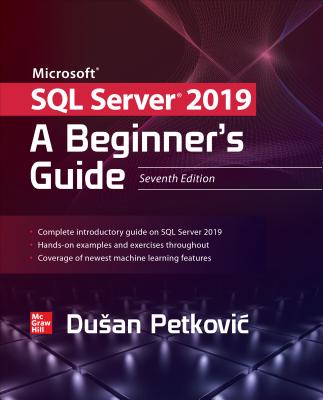Data Modeling Made Simple: A Practical Guide for Business and IT Professionals, 2/e (Paperback)
暫譯: 簡單數據建模:商業與IT專業人士的實用指南,第二版(平裝本)
Steve Hoberman
- 出版商: Take IT With You(r)
- 出版日期: 2009-10-01
- 售價: $1,770
- 貴賓價: 9.5 折 $1,682
- 語言: 英文
- 頁數: 244
- 裝訂: Paperback
- ISBN: 0977140067
- ISBN-13: 9780977140060
-
相關分類:
資料庫、Data Science
-
相關翻譯:
數據建模經典教程, 2/e (Data Modeling Made Simple: A Practical Guide for Business and IT Professionals, 2/e) (簡中版)
海外代購書籍(需單獨結帳)
買這商品的人也買了...
-
 C# 精要 (C# Essentials)
C# 精要 (C# Essentials)$480$379 -
 Linux C 函式庫詳解辭典
Linux C 函式庫詳解辭典$550$435 -
 精通 Shell Scripting (Classic Shell Scripting)
精通 Shell Scripting (Classic Shell Scripting)$620$490 -
 C++ Primer, 4/e (中文版)
C++ Primer, 4/e (中文版)$990$891 -
 Web Data Mining: Exploring Hyperlinks, Contents, and Usage Data 2/e(Hardcover)
Web Data Mining: Exploring Hyperlinks, Contents, and Usage Data 2/e(Hardcover)$2,490$2,366 -
 資電學院計算機概論
資電學院計算機概論$650$585 -
 深入淺出統計學 (Head First Statistics)
深入淺出統計學 (Head First Statistics)$980$774 -
 Windows 7 攻略一本通
Windows 7 攻略一本通$450$383 -
 用實例學 ASP.NET 3.5 AJAX 用戶端篇-使用 VC#
用實例學 ASP.NET 3.5 AJAX 用戶端篇-使用 VC#$720$569 -
 深入淺出 Ajax (Head First Ajax)
深入淺出 Ajax (Head First Ajax)$680$537 -
 Windows 7 使用手冊
Windows 7 使用手冊$399$315 -
 大話儲存-網路儲存系統原理精解與最佳實踐
大話儲存-網路儲存系統原理精解與最佳實踐$550$468 -
 程式之美-微軟技術面試心得【精裝限量版】
程式之美-微軟技術面試心得【精裝限量版】$550$468 -
 Google Android 2.X 應用程式開發實戰
Google Android 2.X 應用程式開發實戰$520$411 -
 Google Android SDK 開發範例大全 2
Google Android SDK 開發範例大全 2$890$757 -
 巧用 jQuery
巧用 jQuery$490$387 -
 ASP.NET 4.0 專題實務-使用 C#
ASP.NET 4.0 專題實務-使用 C#$750$593 -
 深入淺出 Android 系統原理及開發要點
深入淺出 Android 系統原理及開發要點$450$351 -
 Entity Framework 與 LINQ 開發實戰
Entity Framework 與 LINQ 開發實戰$590$502 -
 正確學會 Dreamweaver CS5 的 16 堂課
正確學會 Dreamweaver CS5 的 16 堂課$520$411 -
 Visual C# 2010 程式設計經典
Visual C# 2010 程式設計經典$650$514 -
 探索 iPhone 程式開發實戰 (Beginning iPhone 3 Development: Exploring the iPhone SDK)
探索 iPhone 程式開發實戰 (Beginning iPhone 3 Development: Exploring the iPhone SDK)$480$379 -
 HTML5 & API 網頁程式設計
HTML5 & API 網頁程式設計$450$356 -
 跟 Adobe 徹底研究 ActionScript 3.0 for Flash CS5(ActionScript 3.0 for Adobe Flash Professional CS5 Classroom in a Book)
跟 Adobe 徹底研究 ActionScript 3.0 for Flash CS5(ActionScript 3.0 for Adobe Flash Professional CS5 Classroom in a Book)$620$527 -
 設計模式之禪
設計模式之禪$550$435
商品描述
Data Modeling Made Simple will provide the business or IT professional with a practical working knowledge of data modeling concepts and best practices. This book is written in a conversational style that encourages you to read it from start to finish and master these ten objectives:
- Know when a data model is needed and which type of data model is most effective for each situation
- Read a data model of any size and complexity with the same confidence as reading a book
- Build a fully normalized relational data model, as well as an easily navigatable dimensional model
- Apply techniques to turn a logical data model into an efficient physical design
- Leverage several templates to make requirements gathering more efficient and accurate
- Explain all ten categories of the Data Model Scorecard
- Learn strategies to improve your working relationships with others
- Appreciate the impact unstructured data has, and will have, on our data modeling deliverables
- Learn basic UML concepts
- Put data modeling in context with XML, metadata, and agile development
商品描述(中文翻譯)
《簡化數據建模》將為商業或IT專業人士提供數據建模概念和最佳實踐的實用工作知識。本書以對話風格撰寫,鼓勵您從頭到尾閱讀,並掌握以下十個目標:
1. 知道何時需要數據模型,以及哪種類型的數據模型在每種情況下最有效
2. 以閱讀書籍的自信,閱讀任何大小和複雜度的數據模型
3. 建立一個完全正規化的關聯數據模型,以及一個易於導航的維度模型
4. 應用技術將邏輯數據模型轉換為高效的物理設計
5. 利用幾個模板使需求收集更高效和準確
6. 解釋數據模型評分卡的所有十個類別
7. 學習改善與他人工作關係的策略
8. 欣賞非結構化數據對我們數據建模交付成果的影響及未來影響
9. 學習基本的UML概念
10. 將數據建模與XML、元數據和敏捷開發放在上下文中理解






















